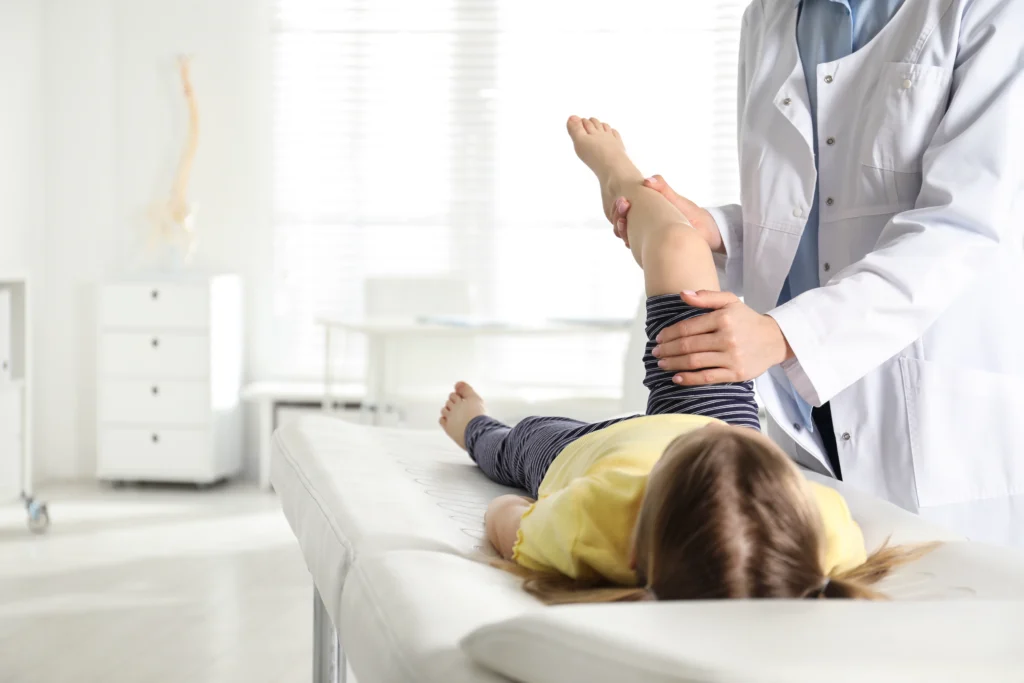If your child is active in contact sports, chances are they’ve had a hip pointer.
What Is A Hip Pointer?
A hip pointer is a deep bruise to the iliac crest—the bony ridge (also called the pelvic brim) on the upper outside of the hip. This causes pain, swelling, or visible bruising at the site of the injury. A hip pointer may also be deeper in the tissue and less obvious on the surface. It usually affects teens more than younger kids.
Hip Pointer Pain
Hip pointer pain is from the blood that accumulates at the impact point, with clotting and a buildup of fluid. This, in turn, puts pressure on the soft tissue and nerves there. Your child may say the spot feels tender to the touch or when moving.
Several muscles attach to that area of the pelvis; these control walking, running, and jumping, and movement and stabilization of the trunk (abdominal area). If hip pointer pain is bad enough, it can make your child’s movements difficult and disrupt the normal function of these muscles until it heals.
Because of the muscles involved, your child could also experience more severe hip pointer pain by walking, running, laughing, twisting, coughing, or even breathing deeply. Some symptoms are:
- limited range of hip motion
- a limp
- trouble standing on one leg, lying on the affected side, or lifting the leg in the air
What Causes A Hip Pointer?
In a word, impact. A hard hit or a hard fall on the pelvic brim causes a hip pointer. Student-athletes are at risk since during sports play, they are often hit on the side of the hip by an opposing player or fall on the ground (and landing on the side of the hip). These impacts can cause a hip pointer.
Common Activities That Can Lead To Hip Pointer
Common activities that can lead to a hip pointer are contact sports: football, ice hockey or field hockey, lacrosse, soccer, and baseball. However, when participating in noncontact sports such as volleyball, basketball, or gymnastics, a bad fall can also lead to a hip pointer.
Skateboarders and inline skaters are vulnerable, given the hard surfaces they are on. Additionally, a bad fall or crash while skiing, snowboarding, ice skating, or cycling can lead to a hip pointer. It’s even possible that hard contact with a piece of sports equipment can bruise the hip in the right spot. Wearing protective gear that’s appropriate for your child’s sport can help reduce the risk.
How To Diagnose Hip Pointer Pain
The orthopedist will diagnose the cause of hip pointer pain based on a physical exam first. The physician will look for signs of bruising and swelling and check your child’s range of motion at the hip and the leg on that side. The exam should include asking about physical activities as well as any recent accidents that could have caused the trauma.
Remember that the bruising may be deep in the tissue in the hip area and not always visible. Therefore, it is common for healthcare providers to order an MRI for a hip pointer to assess the soft tissue and bruising (and rule out more serious conditions). A hip pointer X-ray is also used to look for a broken bone. Because your teenager’s bones are not yet fully grown, the physician will want to check for injury at the growth plates; an MRI and X-ray are helpful diagnostic tools for this.
Treating Hip Pointer Pain
Treating hip pointer pain is generally on the conservative side. Like many other injuries our pediatric orthopedic patients have, we prescribe:
- Rest – even in mild cases, your child should avoid activities that aggravate the pain or could cause another hit to the area. So, no sports or physical activities for a while!
- Frequent ice application on the area – every 1-2 hours for 15 minutes at a time (wrap the ice pack in a towel)
- Wrapping an elastic bandage around the waist/hip area – this provides comfort and support
- Raising the hips with a pillow when lying down
- Anti-inflammatory medications
- Gentle stretching in very short spurts (20-30 seconds) to loosen muscles
These self-care treatments all help alleviate pain, bruising, and swelling.
If your child is experiencing severe symptoms that make it hard to walk, using crutches will limit the weight on the affected hip. We may also recommend physical therapy to help with stretching and strengthening of the core and lower extremities.
Hip Pointer Recovery Time
You should expect your child’s hip pointer recovery time to be anywhere from one to three weeks. For complete soft tissue healing from a hip pointer, recovery time can take two to three months.
Note that, if after two weeks the pain is not subsiding or gets worse, it’s important to contact your child’s physician right away.
Sports After A Hip Pointer
As your child starts feeling better, a slow return to sports and other activities is recommended; an aggressive return too soon after injury can worsen a hip pointer or turn the clock back on recovery time. It can also put your teen at risk for another injury. Conversely, we counsel against an overly cautious approach that prevents movement, since gentle stretching and mild activity will help with healing.
When your teen exhibits a full range of motion in the hip (without limping), has full pre-injury strength and no or little pain, they can get back to their sport after a hip pointer. You should make a follow-up visit with the orthopedist a few weeks after the hip pointer injury to get the all-clear.
Contact The Pediatric Orthopedic Center For Hip Pointer Pain
If your child has experienced an impact or hard fall during sports or other activities and is exhibiting symptoms of a hip pointer, please contact our office to make an appointment for an examination and diagnosis.



